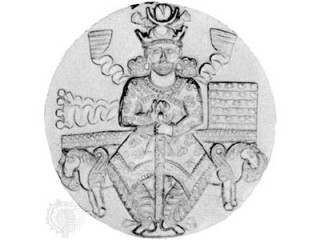
Khosrow I biography
Date of birth : -
Date of death : -
Birthplace : Persia
Nationality : Persian
Category : Historian personalities
Last modified : 2011-09-05
Credited as : King, Mazdakites, Ephthalites
Khosrow I (531-576) was a Persian king and the most illustrious member of the Sassanid dynasty. He is distinguished for both his military achievements and his far-reaching administrative and social reforms.
Under his father, Kavat, Khosrow played a leading role in subduing the followers of Mazdak, a religious leader who preached a communistic creed aiming at the elimination of the causes of hostility among men. The movement gained popularity and for a time enjoyed the support even of the reform-minded Kavat. In the end, however, Kavat gave in to Khosrow's insistence on crushing the movement, a plan which was executed with utter ruthlessness.
Khosrow, who had been appointed crown prince by kavat, first encountered the opposition of his two older brothers. He ended this opposition effectively by putting his brothers and some of their children to death. He then turned his attention to the Mazdakites, who still posed a threat to his rule, and massacred a large number of them, among whom Mazdak also perished. Khosrow's severity, however, was matched by a firm resolve for reforms and deep concern for the administration of justice. He was strictly a man of law and order who believed in the intimate relationship of church and state and in upholding a clear distinction between the different classes of society.
In order to stamp out the causes of widespread dissatisfaction, Khosrow reorganized the Sassanid state and instituted far-ranging reforms. He divided the country into four main provinces, for each of which he appointed a governor (patkospan), a military commander, and a chief inspector. He also thoroughly overhauled the tax system with a view to both stabilizing the state's revenues and correcting tax inequities. He instituted periodic surveys of the land and produce to prevent the recurrence of former abuses. Arab and Persian historians call him Anushervan ("of immortal soul") the Just, a reflection of his reputation of being firm but evenhanded.
Khosrow's foreign policy was marked by his determination to withstand any encroachment upon the Persian borders and by his ambition to extend the Persian frontiers. In these matters he was remarkably successful. In 533, when Khosrow was still beset by the Mazdakite problem, he signed a peace treaty with Rome, stipulating that Rome pay 1,100 pounds of gold toward the upkeep of Darband and other fortresses in the Caucasus against nomadic inroads, that Rome keep the fortress of Dara but not its headquarters in Mesopotamia, and that fortresses captured by each side in Lazica during previous wars be restored.
Justinian, Khosrow's able counterpart, welcomed the peace treaty in order to pursue his conquests in Italy and North Africa, but his successes alarmed Khosrow, who felt equally concerned about Armenia, a Persian protectorate courting Rome. War broke out between the two countries, and Khosrow's armies scored a number of victories. More than once, terms of peace were agreed upon, only to be broken again, sometimes by Rome, sometimes by Persia—a course typical of Persic-Roman relations in medieval times. The conflict with Rome survived Khosrow, whose military operations against Rome were generally more successful than not and who personally conducted his armies even in his old age.
A peace treaty with Rome in 562 allowed Khosrow to turn his attention to the East, where, in alliance with the Khaghan of the Turks, he invaded the territory of the Ephthalites. These were most probably a group of White Huns who had pushed westward and settled on the Persian frontier.
Khosrow's victory extended the frontiers of Persia to the Oxus River and brought Kabolestan, Zabolestan, and Arachosia, among other provinces, under Persian rule. This expansion also made the Sassanid state a direct neighbor of the Turks.
Other military successes by Khosrow included his defeat of the Khazars, an Altaic people who had their capital near the Volga estuary; his campaign in 569 on the northeastern frontier against the Turks who had invaded Persian territory; and his campaign in Arabia in 576 against the Abyssinian conquerors of Yemen. The last campaign extended Persian rule into southern Arabia.
In Persian literature, Khosrow I is credited with justice, wisdom, and military prowess. His reforms imparted new life to the Sassanid dynasty, and his suppression of the Mazdakite movement made the Zoroastrian Church once again supreme. Bozorgmehr, the sage who is reported to have been his vizier and chief adviser, however, is not confirmed as a historical figure.
















